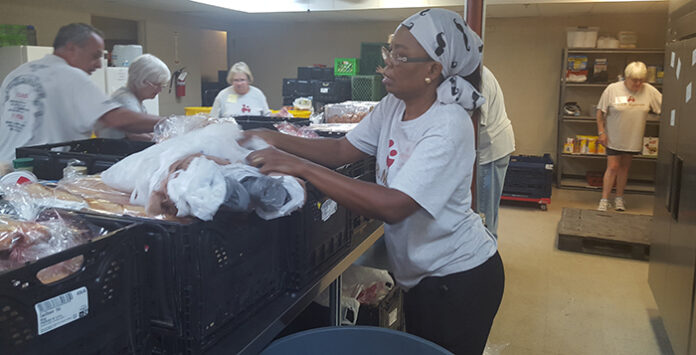
When a food drive by Harrah’s Ak-Chin Casino employees brought in 10,000 pounds of food, it was the equivalent of a month’s worth of supplies for F.O.R. Maricopa food bank.
Coming on April 21, outside the usual holiday giving, it was particularly appreciated. The food bank is under financial stress.
Executive Director Wendy Webb put out a call for help last week when it became apparent F.O.R. Maricopa would struggle to stretch its budget beyond the next four months.
The nonprofit feeds about 500 families a week. Last year, it served 100,000 people.
“It’s a lot for one player,” Webb said.
F.O.R. Maricopa is entering what food banks call the “dry season” for monetary donations. This year, however, is more difficult than usual.
The reason for the financial stress is not what one might expect. Costs have not escalated, and the number of clients has not gone up dramatically. In fact, both have been consistent. The food bank normally has a 20-percent increase in clients every year, but that slowed to 4 percent last year.
Instead, grants and donations have dried up. Fund-raising events have not stirred much interest.
“Even with the events, we maybe make for the whole year $20,000,” Webb said.
Grants are a reflection of the post-recession economy and its residual impact on governmental and organizational budgets.
“They don’t have enough for everybody,” Webb said of organizations that once were reliable resources. “Some maybe overextended themselves and came back and said, ‘Sorry, we thought we could do it, but we can’t.’
“So we’ve either gotten half or none of all the grants we were told were coming.”
Over the past two years, Webb estimated the loss has amounted to $155,000.
“We have great people who care about us; they just don’t have the funds,” she said.
The city of Maricopa, for instance, had to suspend all of its nonprofit spending to meet its own budget.
Angie Rodgers, president of the Association of Arizona Food Banks, said some elements most of the food pantries in the state have in common at this time of year are the migration of the “snowbirds,” who tend to be generous with donations of money and time, and the end of the growing season for many farmers.
“We’re all competing for limited dollars,” Rodgers said.
She said there is also interesting fallout from the end of the recession.
During the recession, many philanthropists who normally would give to arts- and culture-related projects went “back to basics” and gave to organizations that provide food and housing for the less fortunate. With the end of the recession, Rodgers said, “they went back to what they are comfortable with, the arts and culture events.”
According to Feeding America’s annual Map the Meal Gap project, using 2014 data, 25,830 Pinal County children (25.9 percent) are in a situation of food insecurity. For the total population, that number is 15.3 percent. That is a need for an extra $29 million to close the gap. That money is hard to come by.
At F.O.R. Maricopa, the board has examined several ways to tighten its collective belt.
“We’ll trim our food boxes a little bit to see if that helps,” Webb said.
The pantry spends about $5,000 a month on food boxes. She said they will try to cut that by $2,000 a month.
The Department of Economic Security (DES) sets the criteria for how money is spent. That includes The Emergency Food Assistance Program (TEFAP).
“If you take TEFAP food – that’s food we get once a month based on the number of people that we serve – it’s free but it’s maybe two pallets of food. They say then you have to give out food once a month,” Webb said.
F.O.R. Maricopa gives out food twice a week. Webb noted some pantries bend government rules, but she is not willing to try that.
“We could option to not take the monthly food and see if at some point that would become financially in our best interest, if they’re going to cut our food in half anyway,” she said. “So that’s something we’re still looking at as a board and trying to play out those numbers.”
Administrative costs are electricity (averaging $1,300 per month), supplies and other basics. A new refrigerator came from a grant, funds that could not be reconfigured to spend on food.
“At the same time, people aren’t super-excited about paying for food,” Webb said. “They want a truck or a building or a program like our backpack program.”
With funding for even the backpack program – supplying schoolchildren with packs full of food for the weekend – cut in half, Webb would like to see all backpack programs in Maricopa coming together as one effort.
“All of our people are in our database. All of our kids are validated,” Webb said. “That’s why we say ‘Come on over and we’ll do it together. Bring the biggest banner you’ve got. We don’t care.’ That’s what we’re about in this town. It takes all of us to make things work.”
Key initiatives F.O.R. Maricopa identified as important to its identity were the backpack program, the Thanksgiving program and the Christmas program.
“And we’re not going to be able to do all those,” Webb said.
The food bank will have the Christmas gifts for children, but it will not have a carnival or food. Nor will it have food for Thanksgiving, she said.
“When we say we’re out of money, that means I don’t know if we’ll make it until December with the food that we have and the money that we have,” Webb said.
So donations like those from Harrah’s Ak-Chin Casino are not taken for granted by Webb and her volunteers. “They just gave us another month that we can keep our doors open,” she said.




![Elena Trails releases home renderings An image of one of 56 elevation renderings submitted to Maricopa's planning department for the Elena Trails subdivison. The developer plans to construct 14 different floor plans, with four elevation styles per plan. [City of Maricopa]](https://www.inmaricopa.com/wp-content/uploads/2024/04/city-041724-elena-trails-rendering-218x150.jpg)

![Affordable apartments planned near ‘Restaurant Row’ A blue square highlights the area of the proposed affordable housing development and "Restaurant Row" sitting south of city hall and the Maricopa Police Department. Preliminary architectural drawings were not yet available. [City of Maricopa]](https://www.inmaricopa.com/wp-content/uploads/2024/04/041724-affordable-housing-project-restaurant-row-218x150.jpg)










![Elena Trails releases home renderings An image of one of 56 elevation renderings submitted to Maricopa's planning department for the Elena Trails subdivison. The developer plans to construct 14 different floor plans, with four elevation styles per plan. [City of Maricopa]](https://www.inmaricopa.com/wp-content/uploads/2024/04/city-041724-elena-trails-rendering-100x70.jpg)